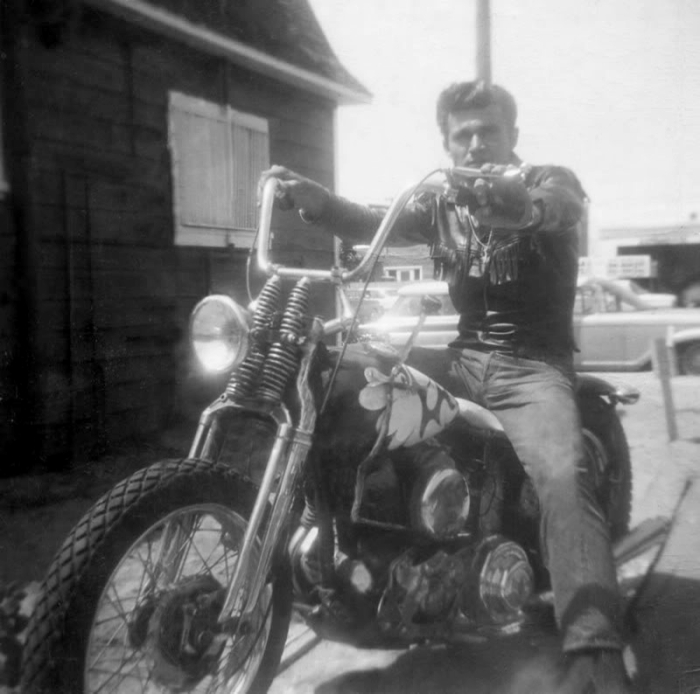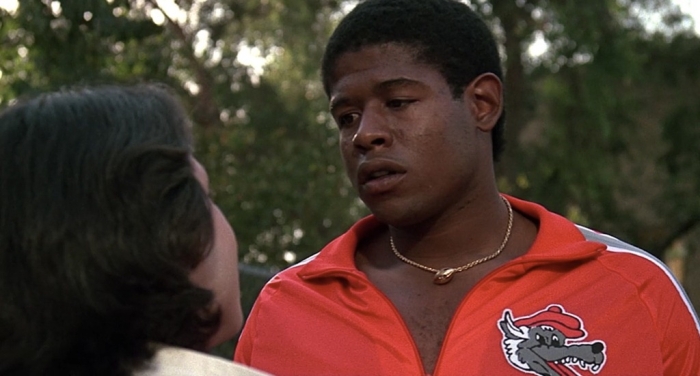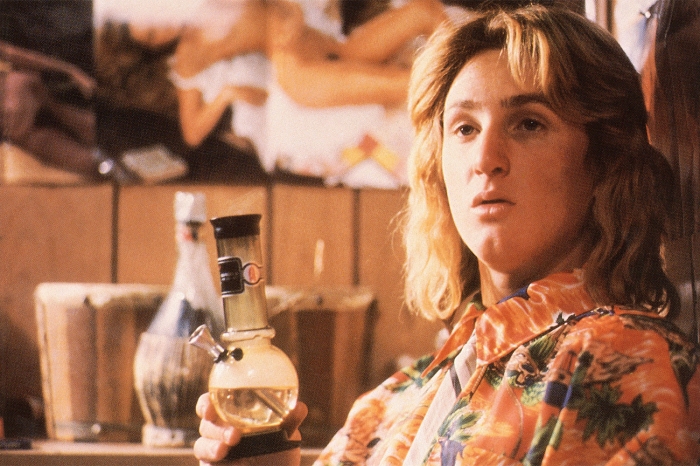1978, Bon Scott and the Heathen Girls, Atlanta, GA. — Image by © 2011 Rennie Ellis Photographic Archive. “Up in his room, Bon orders one of those fancy American cocktails, then dials California for a 20 minute call with an old girlfriend. Lead guitarist Angus Young, the ‘enfant terrible’ of AC/DC, arrives closely followed by Rose Whisperr and the Heathen Girls– four stunningly beautiful, heavily made-up girls who’s singing act at the local gay bars could loosely be called ‘bizarre chic’. The girls and the band had met at the backstage party that manager Michael Browning had thrown an hour or so before at the end of a typical raging AC/DC concert.”
Bon Scott, AC/DC’s legendary frontman, and perhaps the best ever in Rock & Roll, was bluntly and succinctly described by the (now deceased) famed photographer Rennie Ellis:
“His raspy voice, his tattoos, his broken tooth– punk-au-natural I guess one could call it….”
This was back when the badass Bon Scott was still walking the earth. Now, more than 33 years after his passing, the annals of Rock history list him as one of the most epic showmen and vocalists of all time. Rennie Ellis took many of the most striking shots of Bon Scott, capturing the legendary singer’s essence. Rennie also left behind personal recollections of what it was like being with Bon and the boys from AC/DC on tour in their early days, along with quotes from the band in 1978 on how they saw themselves and their music’s impact on the world. It’s really amazing stuff for any hardcore AC/DC fan out there. The mystery around Bon’s passing still hangs over our heads, no thanks to the shady accounts of his drinking partner that night, Alistair Kinnear, re-examined by Classic Rock magazine again this year.
Bon Scott the badass frontman for AC/DC, Moorabbin Town Hall, Melbourne ca. 1974 — Image by © 2011 Rennie Ellis Photographic Archive. “‘I guess I had always had the idea of being rich and having a lifestyle to which I was suited,’ says Bon Scott as he eases himself into the huge chauffeur-driven limousine that will drive him…”
.
Bon Scott’s adoring female fans, Moorabbin Town Hall, Melbourne ca. 1974 — Image by © 2011 Rennie Ellis Photographic Archive
.
Bon Scott & Angus Young, Atlanta, Georgia 1978 — Image by © 2011 Rennie Ellis Photographic Archive. “‘In England,’ says Angus, ‘we were for a while like the ultimate cult band. We were the only band selling records, and I think we still are, on the sheer fact of live performances.’ Bon adds, ‘See there’s a road band, and there’s a radio band. And they’re two different worlds. A radio band very rarely becomes a road band.’”
.
Bon Scott & Angus Young, Atlanta, Georgia 1978 — Image by © 2011 Rennie Ellis Photographic Archive. “We’re a road band. In Europe we never stopped workin’, and we were pullin’ crowds and fillin’ halls. And we built up a following and sold lots of albums. In Germany at one time we had three albums happening. In the charts, all in the top twenty. We had an album in the top twenty in England and our last single sat in the top twenty for six weeks. But not one bit of airplay in England. Our music is just too ‘UP’ for English radio.’”
.
Left to right: Bon Scott, an unidentified “cop,” Malcolm Young, Phil Rudd, Angus Young, AC/DC’s then-manager George Browning, and Mark Evans have a laugh and a drink during a March 1976 photo shoot for “Jailbreak.” — Photo by Philip Morris via
.
More AC/DC & Bon Scott photos:




















.
Below is an excerpt of Joe Bonomo’s review of the book on AC/DC & Bon Scott, “Highway to Hell”–
Six years after Highway to Hell was released, Richard Ramirez was apprehended in Los Angeles. Between June of 1984 and August of the following year, Ramirez had murdered and raped sixteen people in the L.A. area, often leaving behind a sick signature of scrawled demonic ciphers, including a pentagram. Los Angeles police stated that Ramirez was a self-described fan of AC/DC, wore AC/DC t-shirts, and at the grisly scene of one of his violent sprees left behind an AC/DC cap. Allegedly, Ramirez’s favorite song was “Night Prowler,” the final track on Highway to Hell.
A haunting slow-blues, the six-and-a-half minute “Night Prowler” is remarkable for a number of reasons, not least of which is the controlled, vivid band performance in which Angus reaches deep into his love of blues-styled playing and offers affecting, evocative playing. An eerie crawl in 6/8 with the guitars tuned a half-step down, the closer colors in an unsettling way what comes before it. The tune begins with a sharp intake of breath, three chords that outline the music’s dark terrain, and then a tumble into the band performance held aloft by a long, sustained note by Angus that nearly perishes on the strings. Before Bon begins singing, the mood has been established: foreboding, fearful, and dark. Ten years earlier to the month (and only a few miles away) the Rolling Stones had recorded “Midnight Rambler,” a slow-blues similar to “Night Prowler” in its menace and lurch. Some see the Stones’ classic as an influence on Bon and the Young brothers; both songs begin and end in the source material of the blues, Malcolm and Angus’ first love. “Anyone can play a blues tune,” Angus noted to Vic Garbarini, “but you have to be able to play it well to make it come alive. And the secret to that is the intensity and the feeling you put into it.” He adds, “For me, the blues has always been the foundation to build on.”
One of the few songs by other artists that AC/DC would cover was Big Joe Williams’ standard “Baby, Please Don’t Go,” issued as the first song on their debut album in 1975. The guys likely dug Big Joe’s biography: he was a belligerent, itinerant bluesman who spent his formative years in the Delta as a walking musician who played work camps, jukes, store fronts, and streets and alleys from the South through the Midwest. Williams was a hard-working, highly unique and ramshackle kind of player who favored a funky nine-string guitar and a jerry-rigged, homemade amp. The brash and confident punks in AC/DC certainly favored what historian Robert Santelli describes as Williams’ “fiercely independent blues spirit.” The chugging “Baby, Please Don’t Go” became a favorite for Sixties and Seventies rock & roll bands to cover, extend, make their own. Williams’ 1935 version is acoustic mania; critic Bill Janovitz notes that “the most likely link between the Williams recordings and all the rock covers that came in the 1960’s and 1970’s would be the Muddy Waters 1953 Chess side, which retains the same swinging phrasing as the Williams takes, but the session musicians beef it up with a steady driving rhythm section, electrified instruments, and Little Walter Jacobs wailing on blues harp.”
AC/DC loved it. Their take on Muddy’s take of Big Joe’s lament was immortalized in a version broadcast on ABC’s (Australian) Countdown in April of 1975. The band seems to be having a blast with the galloping number, Angus and Malcolm running up and down their frets with a delinquent’s glee, but the kicker — of course — is Bon: he comes onstage dressed like a demented Pippi Longstocking, complete with a short skirt, blonde pig-tails, dark lipstick, and blue eye-shadow. During the solo breakdown, he stands next to Angus and theatrically lights a cigarette, and Pippi’s knee-sock innocent turns into the whore dear to Bon’s heart. Watch Rudd in the video: he can’t keep from laughing at the spectacle.
The blues in “Night Prowler” is slower, sexier, much more sinister than Big Joe’s, and no less indebted to the tradition within which the band has always worked. (I would have loved to have heard John Lee Hooker moan and turn it inside-out.) The tale of a shadowy stalking, though packed with narrative details, wouldn’t have won Bon a Pulitzer. The images in the first verse are hoary, well worn: the full moon; the clock striking midnight; the dog barking in the distance; a rat running down the alley. But Bon’s howling delivery — fully committed, and trusting the time-honored appeal of a dark night’s eeriness — sends tremors throughout the song. Because he believes this stuff, now so do we. The imagery in the second verse is more intimate; we’re in the girl’s bedroom now where she’s preoccupied and scared to turn off the light, fearing noises outside the window and shadows on the blind. Anticipating the second chorus, the verse ends with the singer slipping into her room as she lies nude, as if on a tomb. What’s going on here? Autobiography, or a spec script for a slasher movie? A little of both, likely, given Bon’s personal history and juicy imagination. He sings in the end that he’ll make a mess of her, and I always disliked the line; it adds explicit violence to a scenario that at the fork of fantasy and reality could’ve gone either way. Bon felt that it added to the mise-en-scène, I guess, or he was honestly owning up to hostile tendencies inside himself. Most likely, he was giving his listeners vicarious thrills on the dark side, what they wanted all along.
I didn’t want it. I hardly listened to “Night Prowler” after I bought the album, though I liked the slow burn of the band’s playing and how Angus’ soloing added a voice to the song. The song scared me a little, and I resented having to like a song that I disliked because it’s on a great rock & roll album. Richard Ramirez admitted to loving “Night Prowler” to the point of heinous identification, in part prompting L.A. media to dub him the “Night Stalker,” a nickname that will last in perpetuity. My friends and I rolled our eyes when we heard Ramirez’s story: another nut job trying to use rock & roll as an excuse, as a defense. I remembered years earlier watching The Dukes of Hazzard on television and marveling at the fifty-foot jumps that Bo and Luke would make in the General Lee in some hilly Georgian county. The moment that I belted myself into a Chevy Chevette in the high school parking lot for my first driver’s-ed lesson, I intuited Damn, this thing weighs a ton, and the disconnect between fantasy and actual life was made pretty clear. Ramirez didn’t or couldn’t make such a distinction, and because of that, the closing song on Highway to Hell will be forever linked to a homicidal maniac who tragically took sixteen innocent lives in brutal ways.
When news of Ramirez’s comments made its way into the insular AC/DC camp, the band recoiled, claiming that Ramirez wildly misunderstood the song: it’s just about a horny guy sneaking into his girlfriend’s bedroom at night, innocent, hormonal, high school stuff. Yet Bon Scott’s more treacherous imagery pushes the song into regrettably mean places. I’m not sure that the band can have it both ways.
A typically winsome gift from Bon himself ultimately rescues “Night Prowler.” In the closing moments, as the chords wane, Bon utters under his breath a weird, nasal phrase that I couldn’t figure out at the time. (What is that, some bizarre Aussie mantra?) Eventually I learned that he’d said, “Shazbot, Na-Nu, Na-Nu.” As AC/DC were recording in the Spring of 1979, Mork and Mindy was ranked third in American television Nielson ratings; Robin Williams’ interstellar character from the planet Ork was invading living rooms and rec rooms at a happy rate, and Bon was watching. “Na-Nu, “Na-Nu” was an Orkan greeting; “Shazbot” an Orkan curse. Maybe that’s what appealed to Bon: at the end of the band’s best album he gets to say hello and swear at the same time, channeling his inner alien. It’s testament to the band’s sense of humor that they kept the aside on the album. It’s a perfect way to send up the danger and fear lingering after “Night Prowler.”
The album ends with a joke, the final words from by Bon Scott on an AC/DC album. Shit! Hello! Perfectly weird.’
Bon Scott: The Mysterious Death of AC/DC’s Legendary Frontman by Classic Rock
RELATED TSY POSTS:
THE PHOTOGRAPHY OF RENNIE ELLIS | NO STANDING, ONLY DANCING
THE DOORS | WHEN THE MUSIC’S OVER MORRISON HOTEL & HARD ROCK CAFE
THE LIZARD KING & THE LEGEND OF HIS LOST SHELBY GT500
MACHINE HEAD | THE EPIC 1972 ALBUM THAT PUT THE “DEEP” IN DEEP PURPLE
CHECK OUT: The Rennie Ellis Photographic Archive
























































































































